Back
Time for your 100-million-year overhaul.
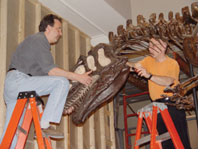 The
fancy word for it is “disarticulation.” And
it’s a big part of Carnegie Museum of Natural History’s Dinosaurs in Their World expansion and renovation
project. The
fancy word for it is “disarticulation.” And
it’s a big part of Carnegie Museum of Natural History’s Dinosaurs in Their World expansion and renovation
project.
Over the next three years, a team of experts led by the
very best in his field, Phil Fraley, will give the museum’s
fossilized dinosaur skeletons a complete overhaul. The
specimens are being disassembled, piece by piece, then
trucked to a studio in Hoboken, New Jersey, for a meticulous
makeover. They’ll return to an exhibit area nearly
three times the size of the current Dinosaur Hall. There,
they’ll be put back together again in more dramatic—and
more scientifically accurate—poses. They’ll
also be joined by a few new dinosaurs.
Earlier this year,
the project got a big boost with a $3 million gift from
the Richard King Mellon Foundation,
which
brings the total raised to date to $31 million. And on
March 10, Museum Director Bill DeWalt was joined by Museum
Board Chair Jack Barbour, Carnegie Museums Interim President
Suzy Broadhurst, Pittsburgh Mayor Tom Murphy, and other
local dignitaries at an official groundbreaking celebration.
Visitors are welcome to check out the disarticulation
behind the safety of viewing walls now surrounding Dinosaur
Hall,
as well as through webcam shots on the museum’s
web site at www.carnegiemnh.org.
Says Bill DeWalt: “We’re
combining two things children of all ages enjoy—dinosaurs
and construction.”
Not just another teen film festival.
 Rory
Kennedy (right), award-winning documentary producer and
daughter of Robert F. Kennedy, is a woman who lives
life with great purpose. In April she challenged teenagers
gathered at Carnegie Science Center to do the same, stressing
the ability teens have to bring about change. Rory
Kennedy (right), award-winning documentary producer and
daughter of Robert F. Kennedy, is a woman who lives
life with great purpose. In April she challenged teenagers
gathered at Carnegie Science Center to do the same, stressing
the ability teens have to bring about change.
The opportunity
she spoke about is a new film festival and competition
called the CAUSE (Creating Awareness and
Understanding of Our Surrounding Environment) Challenge.
A joint effort of Carnegie Science Center’s SciTech
Spectacular, Bayer Corporation, and Pittsburgh Filmmakers,
the program challenges budding filmmakers of tomorrow to
produce videos that promote environmentalism.
"
I saw how much impact a film can really have," Kennedy
said of one of her earliest films, Women of Substance,
a look at mothers torn between their maternal instincts
and their drug addictions. "It opened up people's
minds."
The student films will be evaluated by a panel
of judges, and the finalists will be screened at the Science
Center’s
SciTech Spectacular in September.
Won’t
you be my (miniature) neighbor?
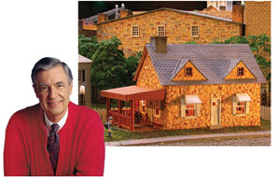 The village part
of Carnegie Science Center’s Miniature
Railroad & Village® has gained its first celebrity
resident. In honor of the late Fred Rogers, a scale model
of the familiar brown-and-white house from Mister Rogers’ Neighborhood officially became the newest addition to the exhibit on
March 19, 2005, the day before what would have been the
beloved local icon’s 77th birthday. The village part
of Carnegie Science Center’s Miniature
Railroad & Village® has gained its first celebrity
resident. In honor of the late Fred Rogers, a scale model
of the familiar brown-and-white house from Mister Rogers’ Neighborhood officially became the newest addition to the exhibit on
March 19, 2005, the day before what would have been the
beloved local icon’s 77th birthday.
Carnegie Science
Center’s Coordinator of Historic
Exhibits Patty Rogers (no relation), with some part-time
help from model-maker/Mayor-of-Pittsburgh Tom Murphy, completed
the project in three months, carefully carving the house
out of beeswax. As a scaled-down red trolley zips by, a
miniature Mister Rogers, complete with red sweater and
blue sneakers, sits with two children on the front porch,
swinging—gently, of course—while inside, another
Mister Rogers puts on his shoes.
“Mister Rogers is in our hearts forever,” Rogers says. “We
added this model to commemorate his birthday and honor his connection to the
city.” Somewhere, even humble Fred Rogers has to be at least
a tiny bit proud.
A big discovery of one hungry little
landlubber. 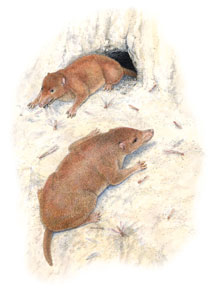 About 150 million years ago, long before
the earliest cartoons, a funny-looking character was
known for his massive forearms
and unusual way of eating. About 150 million years ago, long before
the earliest cartoons, a funny-looking character was
known for his massive forearms
and unusual way of eating.
Nicknamed “Popeye” by
the team of Carnegie Museum of Natural History researchers
that recently published
its findings about him in the journal Science, the chipmunk-sized
species of mammal developed special equipment for burrowing
in the ground to feed on termites, pretty much like armadillos
do today. Until this find, scientists assumed that early
mammals all fed the same way: by gulping down insects or
worms on the surface, one at a time.
Illustration: Mark Klingler “
It's a most interesting way of life for such an ancient
animal," says Zhe-Xi Luo, curator of Vertebrate Paleontology
at Carnegie Museum of Natural History and the lead author
of the paper that introduced the world to Popeye.
The mammal’s
disproportionately large forearms are what earned him his
nickname, which is a lot easier to
say than Fruitafossor windscheffeli (Fruita is the Colorado
town near where it was found, Fossor is Latin for “digger,” and
Wally Windscheffel is the Carnegie Museums volunteer who
found the fossil
in 1998). And it seems he remained a rare breed for many,
many years. Says John Wible, curator of Mammals and co-author
of the paper, “Nothing like this occurs in the fossil
record until almost 100 million years later, when the earliest
armadillos appeared in South America.”
What a party for The Warhol!
Photo: Lisa Kyle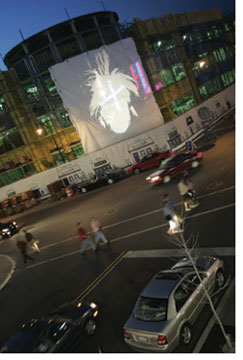
You
never know quite what you’re going to get when
Teresa Heinz Kerry takes the podium. It could be eloquence,
candor, controversy, or, if you’re The Andy Warhol
Museum, several million dollars.
On Saturday evening, April
9, addressing several hundred guests gathered at the Spike-a-delic
gala to celebrate
the museum’s 10th anniversary year, Heinz Kerry made
the surprise announcement that the Howard Heinz Endowments
had approved a $4 million grant to the museum, the third-largest
in The Warhol’s history. Teresa Heinz Kerry chairs
the Howard Heinz Endowment and is a Carnegie Museums of
Pittsburgh trustee.
“
My late husband John and I supported bringing The Warhol
here because Andy was a Pittsburgh native son,” she
said in her speech. “His was a unique and special
talent, and we in his hometown had an opportunity to embrace
him as our own.”
Praising Museum Director Thomas
Sokolowski, Heinz Kerry added, “The first 10 years
of this museum have been years of playfulness and experimentation.
I think Andy
would have been proud.” The gala celebration just
so happened to coincide with Sokolowski’s birthday.
The fundraising dinner and dance party, dubbed “Spike-a-delic” in
honor of Andy Warhol’s passion for shoes (he once
worked as a shoe illustrator for I Miller), was held at
the SouthSide Works and featured, naturally, a footwear
theme. Damian Soffer, a member of The Warhol's Board of
Directors, and his wife Teri hosted the gala that turned
an unfinished floor of the building into a Studio 54 look-alike.
What are 80,000 pictures worth?
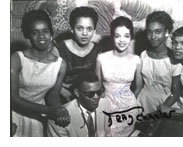 In the 1930s
and ‘40s, the Pittsburgh Courier was
the country’s largest-circulation African-American
newspaper. In words and pictures, it spoke for the city’s
black population. And the person snapping most of the pictures
was Charles “Teenie” Harris. In the 1930s
and ‘40s, the Pittsburgh Courier was
the country’s largest-circulation African-American
newspaper. In words and pictures, it spoke for the city’s
black population. And the person snapping most of the pictures
was Charles “Teenie” Harris.
Peering without
prying, examining without exploiting, Harris amassed the
world’s most extensive portrait of African-American
urban life. His 40-year career yielded around 80,000 photos,
of which only a small fraction have ever been released.
Carnegie Museum of Art purchased the negatives in 2001,
three years after Harris’s
death, as a way of preserving the collection, allowing
public access to the work, and trying to identify the people,
places, and events depicted in the photos.
That goal moved
a lot closer to reality recently when the National Endowment
for the Humanities (NEH) awarded the
museum $340,000 to preserve, catalogue, and archive over
26,000 of the negatives and scan nearly 34,000 more. “The
NEH's support acknowledges the importance and value of
this archive to scholars and the general public,” says
Richard Armstrong, the Henry J. Heinz II Director of Carnegie
Museum of Art.
The Museum of Art, with the help of the
public, has already identified the people and places
in 1,000 Teenie Harris photographs. And starting August
6, another 3,500 photos will be on
view
at the museum or online at www.cmoa.org.
Back
| Top |